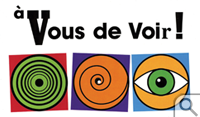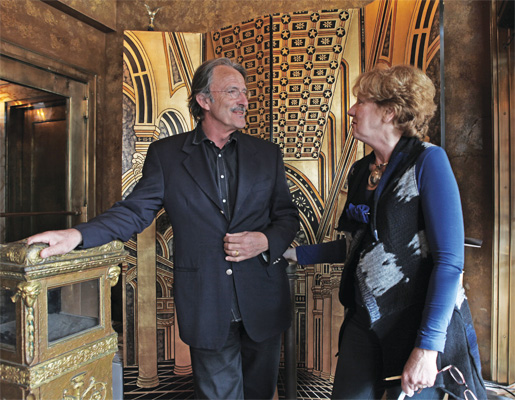À vous de voir!
Texts explore French filmmaking from the inside out.
Since the invention of the Cinématographe in 1895, cinema has played a key role in French culture. French filmmaking, in turn, has had a huge influence upon the industry worldwide. With more cinemas per inhabitant than any other place in the world, the French love movies.
Maryse Fauvel, professor of French and Francophone studies, loves them too.
Fauvel recently completed the second installment of a two-part text—written in French— on French filmmaking. À vous de voir! offers a critical analysis of 24 Francophone films, as well as a step-by-step explanation of film production.
The book’s title is a play on words, Fauvel says. Literally, à vous de voir means “it’s up to you to see,” she says.
“I want readers and my students to learn to look at movies and make decisions concerning all of the meanings. I want them to view films with different approaches,” Fauvel explained. “Films are complex works of art which use and manipulate cinematographic codes, but they also employ historical, political, technological, cultural and sociological references.”
Fauvel is doing her part to ensure that her students are equipped with the tools to analyze and appreciate films. What’s more, many are learning the steps involved in making a film. She has incorporated the students’ work, a multimedia CD, into the second volume of À vous de voir!
“Making films is technically within the reach of any William & Mary student. We would never teach our students to read without also asking them to write,” she says. “How can we teach them about film, without teaching how to make movies?”
Fauvel says that her book is intended to reach a wide audience interested in discovering Francophone cinema. She doesn’t write books in English and she doesn’t teach in English.
“To publish in English for me would mean to present French/Francophone cultures through a filter,” Fauvel explained. “It is important to see the world from other points of view, in different languages, and not always in English, not always from an American point of view.”
Cultural & political realities
Fauvel explains that the idea of “Francophone” incorporates not only cultural concepts—it also incorporates a set of political and geo-political shifts. The idea acknowledges realities such as decolonization and political/cultural self-determination, she says, while at the same time remaining aware of continuing links between France and its former colonial possessions. Thus, “Francophone culture” embraces post-colonial France and former French colonies such as Algeria and Vietnam.
“Film is a great medium to study French/Francophone cultures,” she says. “It’s entertaining, but beyond that, it is a medium which reflects the evolution of French/Francophone history and concepts like identity, women’s and men’s roles in society, images of the body, homosexuality and bisexuality, AIDS, relations to space, daily life, racism, the exclusion or inclusion of minorities, social or political problems, etc.”
À vous de voir! explores other societal changes, including advances in technology, the progress of film studies, and the evolution of an increasingly visually-oriented audience. Each of its 14 chapters contains analyses of three films—directed by Amari, Tlatli, Haneke, Jeunet, Varda and Truffaut to name a few—through various approaches (historical, feminist, postcolonial, for example). The chapters mirror the steps necessary to the making of a film, from the script, to the storyboard, the mise en scène (staging), the shooting, and—ultimately—the editing and marketing strategies.
Producing a film
“Since 2007 a lot of my students have produced everything necessary toward not only a film analysis—which is usually what we expect in a film class—but they will produce a movie. Working in teams, they write a script, and then make the storyboard which is necessary to prepare and explain the work in advance before shooting so that you know exactly which material you will need—sequentially,” Fauvel said.
 The storyboard illustrates, for example, where to put the light, what kind of sound would be collected to that picture, and what kind of material is needed.
The storyboard illustrates, for example, where to put the light, what kind of sound would be collected to that picture, and what kind of material is needed.
“Once they have completed the storyboards, I comment on them and then they produce a short movie,” she said.
Fauvel notes that in France, the teaching of film studies is encouraged in high schools and at the university level—but the French government actually sponsors the film industry and supports art-movie theaters. French film, of course, has played a large role in terms of global film making, contributing terms like “mise-en-scène,” “film noir,” and “auteur” to the international filmmaker’s vocabulary.
French film is often considered to be intellectual, even edgy. But Fauvel warns of the dangers of pigeonholing such a dynamic form of expression.
“The definition of what makes a movie ‘French’ has evolved greatly in the past twenty years,” she said. “A traditional definition of French cinema served the interests of the traditional nation-state until the 1980s. But more recently, the French state encourages the development of a post-national and transnational cinema competing for a share of global markets.”
Today, Fauvel says, French cinema includes not only views of French people and French stars, but also the often marginalized postcolonial voices. “Instead of showing an idealized image of the nation, this cinema exposes, from moveable centers and margins, struggles, traumas, successes and differences,” she said.
Focus on the auteur
Like U.S. movies, French cinema is also defined to a certain extent by “stars.” But Fauvel points out French movies are traditionally identified with their auteur. The title of a movie is usually accompanied by the name of the filmmaker. As a result, French cinema buffs follow filmmakers such as Renoir or Truffaut, rather than stars such as Belmondo or Depardieu.
Fauvel encourages students and film-goers alike to approach movies critically, to analyze the angles of the camera, the scale of the shots, the editing choices and the effects of these choices on the spectators.
“Intellectually, for instance, one should question how cinematic language works. What are the effects of the various techniques on the viewers? How do films question the world? Which elements are borrowed from other films and why? How does intertextuality (references linked to well-known films) manipulate the viewers?”
It’s up to you to see. ![]()















